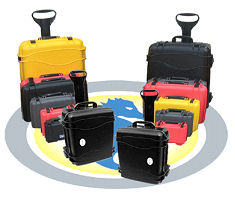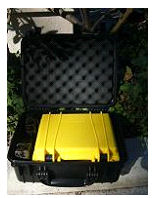 By Megan Davies, Waterproof Case Company
By Megan Davies, Waterproof Case Company
December 21, 2011 (San Diego’s East County) –A great way to secure your valuables, particularly in wildfire-prone East County, is to create an underground cache. The same methods can also be used to create a survival cache or time capsule. For extended underground applications we recommend our Seahorse line of cases as the first choice primarily because they are the only cases on the market that are truly rust proof. Even the hinge, latch and handle pins are made in molded resin. This applies to case models SE-120 through SE-720. The larger SE-920 and SE-1220 do have metal screws for the telescopic pull handle assemblies. Even then, the screws are stainless steel, but still not 100% rustproof, especially underground for extended periods of time.
 For smaller cases than the Seahorse line offers, I recommend any of our Pelican, SKB, S3 cases, Starlight or Underwater Kinetics, or B&W cases.
For smaller cases than the Seahorse line offers, I recommend any of our Pelican, SKB, S3 cases, Starlight or Underwater Kinetics, or B&W cases.
Although all of our cases are completely waterproof and airtight, it is always better to be safe than sorry, especially for an application such as this one. If you happen to be in a big hurry, you can simply dig a deep enough hole, drop in the case and cover it back up. There are however, a number of considerations and precautions that could be taken to ensure long term storage protection that are well worth the effort. Whether it be for a Time Capsule or for a Survival Cache, the risk of losing the contents to moisture is not worth avoiding a few more steps.
To be really safe we recommend that the overall approach to protect the gear or items be done using a series of waterproof layers. At the simplest level this would mean using one large case to house a smaller case inside. Even better, use several smaller cases inside a larger case. This method would offer you a layered protection so that in the unlikely event that the outer case were to be breached, the smaller cases inside would continue to protect the items being stored. Redundancy is well known by survivalists as the primordial approach to preparedness, in this case by ensuring the continued protection for what could become extremely valuable survival gear.
 An example of this approach would be using an SE-300 case inside an SE-520 or SE-720 case. If you really want the ultimate case, choose the SX-520 or SX-720 case instead of the SE series as the exterior case. The SE-300 case fits perfectly inside either of the larger models.
An example of this approach would be using an SE-300 case inside an SE-520 or SE-720 case. If you really want the ultimate case, choose the SX-520 or SX-720 case instead of the SE series as the exterior case. The SE-300 case fits perfectly inside either of the larger models.On the sides of the SE-300 case one could store several additional smaller dry boxes that would also help keep the gear separated and organized. Don't hesitate to contact us if you need us to verify that your selection of cases fit inside one another. We have all of our case models in stock and we will be happy to help you with the perfect solution.
The items going into the cases should at the very least be put inside on of our Loksaks or other selection of Dry Bags. You should consider using our Dry Bags especially for electronics such as VHF or CB radios, Walkie Talkies or GPS units so that during the real emergency situation, the equipment continues to be protected from rain, snow, sea spray or any of the other elements mother nature will dish out even while in use.
You should consider using our Dry Bags especially for electronics such as VHF or CB radios, Walkie Talkies or GPS units so that during the real emergency situation, the equipment continues to be protected from rain, snow, sea spray or any of the other elements mother nature will dish out even while in use.
 You should consider using our Dry Bags especially for electronics such as VHF or CB radios, Walkie Talkies or GPS units so that during the real emergency situation, the equipment continues to be protected from rain, snow, sea spray or any of the other elements mother nature will dish out even while in use.
You should consider using our Dry Bags especially for electronics such as VHF or CB radios, Walkie Talkies or GPS units so that during the real emergency situation, the equipment continues to be protected from rain, snow, sea spray or any of the other elements mother nature will dish out even while in use.The use of desiccants and oxygen absorbers is also highly recommended as a means of trapping residual moisture that may have been enclosed in the bags and cases. It would be terrible to open your cache or Time capsule after years of storage and find that your gear has been damaged by rust from moisture trapped inside when you packed the goods. Read more about storage on our Firearms Storage Article.
Additional measures can be taken to further ensure successful long term storage conditions. Depending on the size of the Time Capsule case or Cache case being used, it can now be placed inside a large plastic bag or sealed with a large food storage bag or one of those clothes storage vacuum bags. Wrapping the case in heavy mil. plastic sheet would be another option that can also help. This outer sheeting will keep dirt away from the nooks and crannies of the latches and hinges. Dirt has a way of working its way into every crevice and it will be easier to deal with a clean case when you dig it back up.
After choosing the most appropriate location of where to bury your Time Capsule or Survival Cache it is now time to prepare the hole. The hole should be dug to about three or four feet deep. This is easier said than done and you may choose to not go as deep. The hole should deep enough so that when the case is laying inside, the top of the case is at about two feet below ground level. This is the minimum depth required to overcome most ordinary metal detectors and that in cold climates you made it below the frost line.
I'm sure that military metal detectors are capable of detecting items that are deeper and I will address that with one more countermeasure in just a moment. The best possible hole design will allow for drainage around and below the case by creating a six to twelve inch layer of gravel or loose stones under the case.
The center of the hole should be raised with the gravel so as to create a mound inside the hole upon which the Time Capsule or Cache case will be placed. Lay a sheet of heavy mil. plastic or a sheet of tar paper large enough over the case allowing the edges to drape to the sides of the mound and below the bottom of the case. This will help shed water away from the case during heavy rains. The top of the case should now be at least two or more feet deep inside the hole. Finish filling the hole with dirt, pack down and cover the surface of the fresh dirt with leaves and debris to match the surrounding area. You will need to scatter any leftover dirt or be prepared to haul it to another location.
If you are concerned about someone finding your Cache or Time Capsule with a powerful metal detector you can attempt to deceive detection by burying a decoy in the form of large piece of sheet metal, such as the side of a clothes dryer, at about six inches to one foot deep (about one foot above your Cache) to trick searchers. If your decoy is found, hopefully that will satisfy searchers enough for them to move on to another location. You can also scatter and bury several pieces of metal pipe, nuts and bolts around the general area to trigger detection of numerous metallic items.
And now, don't forget where you put it! We won't be able to help you with that. Always prepare for the worst and hope for the best!








Recent comments